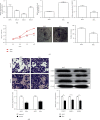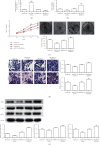Downregulation of PART1 Inhibits Proliferation and Differentiation of Hep3B Cells by Targeting hsa-miR-3529-3p/FOXC2 Axis
- PMID: 34484336
- PMCID: PMC8410447
- DOI: 10.1155/2021/7792223
Downregulation of PART1 Inhibits Proliferation and Differentiation of Hep3B Cells by Targeting hsa-miR-3529-3p/FOXC2 Axis
Abstract
Background: Long noncoding RNAs (lncRNAs) are an important subtype of noncoding RNAs (ncRNAs) and microRNA sponges regulate protein-coding gene expression. The lncRNA prostate androgen-regulated transcript 1 (PART1) was implicated in the process of several cancer pathogeneses. However, studies on the regulation of PART1 expression and its mechanism in liver cancer are lacking.
Methods: qRT-PCR and western blot were used to detect PART1 levels in liver cancer serums and cell lines. Cell proliferation, migration, and invasion were detected using CCK8 assays, cell clones, and transwell assays. Interaction between PART1 and miR-3529-3p and forkhead box protein C2 (FOXC2) was confirmed using dual-luciferase reporter assays.
Results: We revealed that expression levels of PART1 and FOXC2 are significantly upregulated and the miR-3529-3p expression level significantly decreases in the serum while high expression level of PART1 is positively associated with tumour size, BCLC stage, and TNM stage. shRNA of PART1 can significantly reduce the ability of cell migration and invasion by regulating AKT signalling associated with the reduction of MMP-2 and MMP-9 protein expression. Dual-luciferase reporter assays showed that PART1 can sponge miR-3529-3p, which targets FOXC2 in liver cancer cells. The promoting or suppressing effect of PART1 for Hep3B cell proliferation, invasion, and migration is revised by miR-3529-3p mimics and inhibitors.
Conclusion: Results showed that downregulation of PART1 can partially inhibit proliferation and differentiation by targeting hsa-miR-3529-3p/FOXC2 axis.
Copyright © 2021 Zhicheng Weng et al.
Conflict of interest statement
The authors have declared that no conflicts of interest exist.
Figures





References
LinkOut - more resources
Full Text Sources
Research Materials
Miscellaneous

